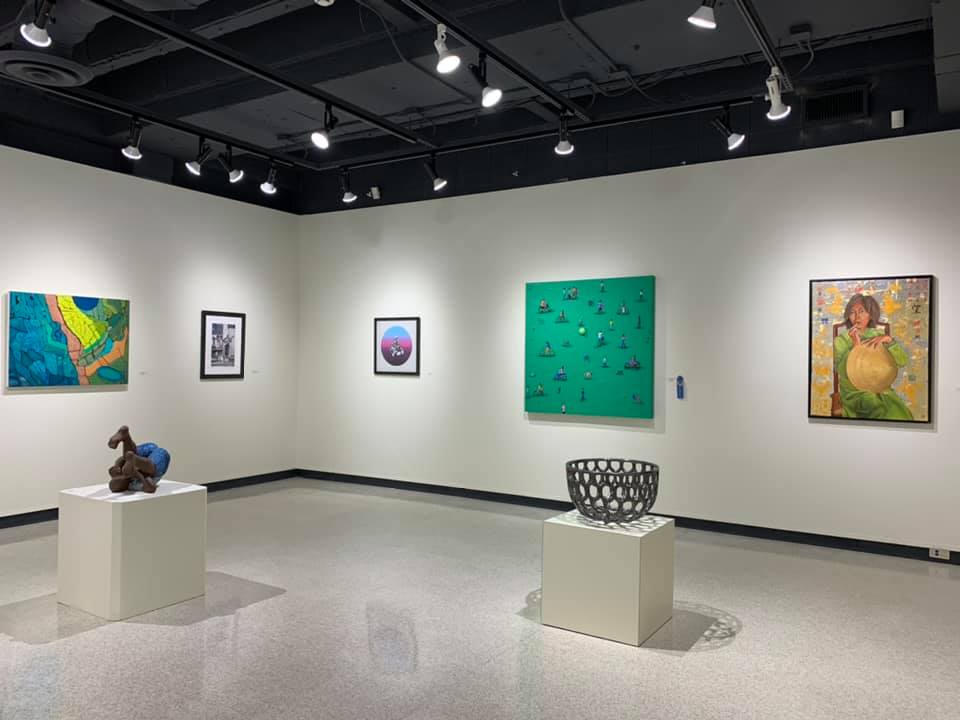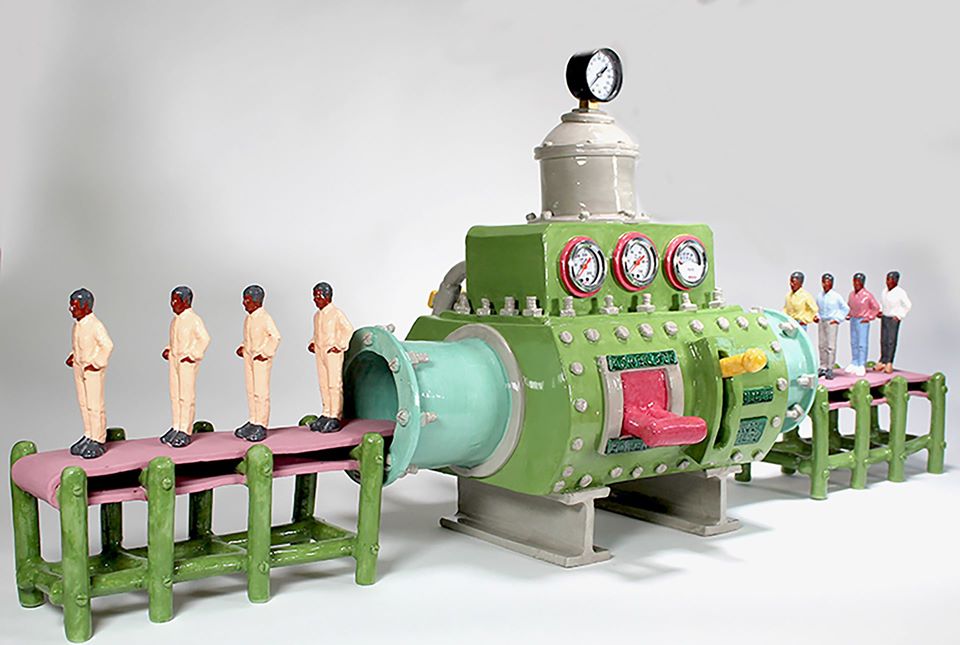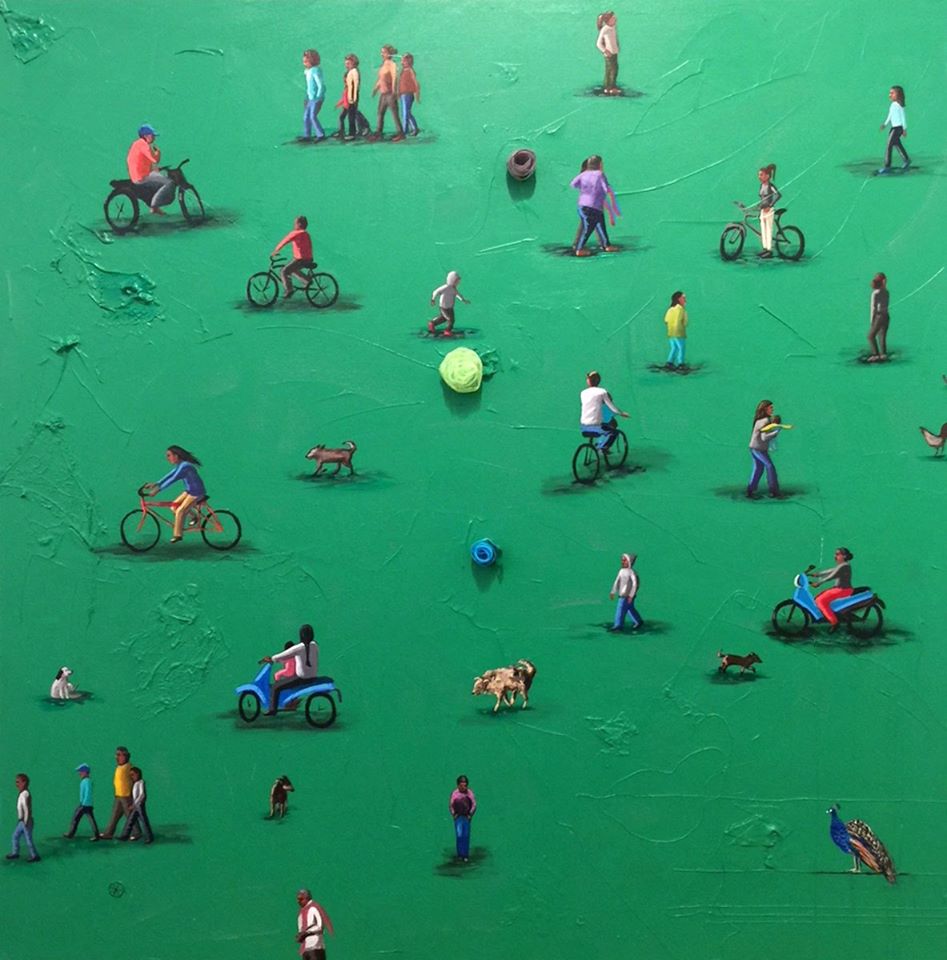By Sophia Dong

Dedo Maranville Gallery’s Valdosta National 2020 exhibition presented several distant artists from across the nation. The artworks were judged, and the placement was announced during the opening of the exhibition. Numerous forms of media were present at the gallery. The exhibition received submissions from artists across the nation. Although there were a variety of subjects and media, the gallery’s spacing of the artwork made the gallery appear cohesive. The gallery used white and bland walls to give the artwork proper breathing space where you couldn’t be distracted by other artwork that was presented in the gallery.
The artwork that was talked about the most was Conveyer Belt of Justice by Ramaya Baba. The artist presented a playful sculptural piece of a machine where black African Americans go through the machine called the justice system with a handle set to pending. The artwork displays more pastel and playful colors to represent a serious topic. The machine has three settings; guilty, not guilty, and pending. The handle was set to pending. On one end of the conveyor belt are African American men in semi-formal clothing but on the other end, the result of the conveyor belt conveys African American men in prison uniforms. This is a bold call out to our current justice system where African American males are more likely to be thrown into prison when they haven’t been proven innocent or guilty. The artwork boldly represents the reality of racial bias in the American justice system. We see a reality where African Americans do not receive the promised justice of the justice system. The justice system is represented as a machine due to the lack of empathy for the ones who are thrown into jail without concrete evidence.

Lathan Masteller presented the gallery with an interactive piece called Salvador Mundi AR, and this piece uses an appropriated image of Salvador Mundi. It was an interesting interactive piece of art; viewers were advised to download the Artivive application to see the shifting of the augmented reality print of Salvador to the original image of Salvador Mundi. Salvator Mundi is one of Leonardo Da Vinci’s paintings and depicts a bearded man, who could be Jesus, holding a glass sphere with his right hand and making a gesture by sticking out the thumb, index, and middle finger. It is the most expensive painting that has been sold at a price of $450,000,000 dollars. Salvator Mundi is a Latin phrase that means “Savior of the World”. The AR twist with this Renaissance painting was interesting to see because AR is something typically used in games like Pokemon Go or AR photography used in a gallery. Seeing an AR piece in a gallery applied more artistic value to augmented reality.

One particular piece caught my eye, Studio with Smokestack Skull. It’s a black and white print of a linocut by Scott Raynor. Linocut is a printmaking technique where the artist carves a sheet of linoleum. They would make a print or a stamp by rolling ink on to the surface of the carved linoleum sheet and make a stamp or print on a piece of paper. The artwork was in a similar style to Picasso’s one layer printed linocut. From a distance, it was hard to tell what the piece was about. However, through closer inspection, there appears to be a sort of studio or living room. My clue as to why this is a studio is through the title of the artwork. The walls are wooden because the carving of the wall appears to be like wood. There’s a skull-shaped smoke stack with smoke coming out of it. With the guitar leaning on the wall, a bird flying through the building, and lemons placed on the table, it reminded me of Vanitas. Vanitas is a symbolic artwork that deals with the subject like death but contrasted with wealth. It uses a person’s possessions to signify that everything has an end. Like the lemon in this lino print, eventually one day they will rot. The guitar represents the music that will stop playing, the skull smoke stack problem represents death itself.

After reviewing the winners of the gallery, I am puzzled by why the first place painting won its place. Caminos/Paths by Valerie Aranda took first place, and it is a large painting. The content of the painting is people you typically see in the park. The painting has a green backdrop with figures of people walking, jogging, riding their bikes, and walking their dogs. The piece has a sculptural element of floral puffs made from tulle, a lightweight cloth material that most often appears on ballerina’s tutu, that were placed more in the center. From closer inspection, you can see Aranda uses different items like cut-up lace underwear, a folded origami crane, string, and crumpled paper that created texture underneath her painting. The artist said that she gathered these materials from her students and applied them to her work. The reason why I am puzzled with why I see this painting is voted first place is because it resembles something I would generically see on a print or a t-shirt design. The sculptural element of the painting was given to the artist by her student. Although it has a significant meaning of community in the painting, it seems to be placed last minute. It makes the work imbalanced because of the sculptural elements where most in the center of the canvas. Instead of placing the sculptural element mostly in the center, perhaps spacing them out would make the composition more interesting.
My personal experience with the gallery was, overall, pleasant. The gallery exhibition makes some sense. It was interesting to see art from different artists from the country. However, I did not find their artworks revolutionary. Most of the artwork was built on foundations that previously existed and have been interpreted many times. I didn’t find much great artwork within this gallery, but I don’t believe this was bad. The selection of artwork that was presented was lackluster. Despite my opinion, I would still suggest you see the gallery for yourself.
Sophia Dong is a Bachelor of Fine Arts major studying at Valdosta State University. She is pursuing a career of being a UI designer.